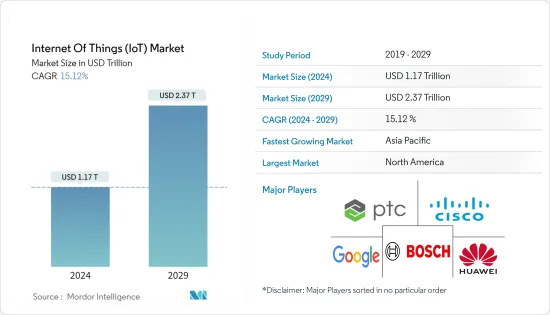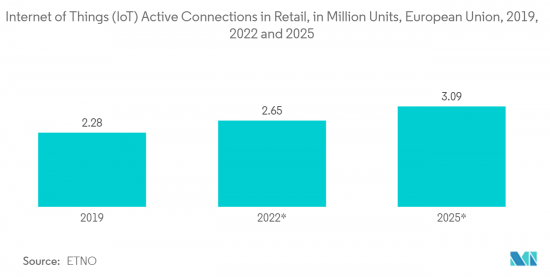PUBLISHER: Mordor Intelligence | PRODUCT CODE: 1403099

PUBLISHER: Mordor Intelligence | PRODUCT CODE: 1403099
Internet Of Things (IoT) - Market Share Analysis, Industry Trends & Statistics, Growth Forecasts 2024 - 2029

The Internet Of Things Market size is estimated at USD 1.17 trillion in 2024, and is expected to reach USD 2.37 trillion by 2029, growing at a CAGR of 15.12% during the forecast period (2024-2029).
During the COVID-19 pandemic, the vendors in the market are collaborating with several organizations to offer emerging technology-enabled solutions to healthcare organizations to help them overcome the crisis effectively. For instance, at the end of January, the Shanghai Public Health Clinical Center (SPHCC) used the California-based connected health startup VivaLNK's continuous temperature measuring device to monitor COVID-19 patients, reducing the risks of caregivers being exposed to the virus.
Key Highlights
- IoT technology is the keystone for various organizations to digitally transform, thus empowering them to upgrade the existing processes by creating and tracking new business models. Enterprises and service providers have considered IoT the key enabler to augment digital transformation and unlock operational efficiencies. The growing adoption of IoT technology across end-user industries, such as manufacturing, automotive, and healthcare, is positively driving the market's growth. With the traditional manufacturing sector amid a digital transformation, IoT is fueling the next industrial revolution of intelligent connectivity. This is changing how industries approach increasingly complex processes of systems and machines to improve efficiency and reduce downtime.
- Industry 4.0 and IoT are central to new technological approaches for developing, producing, and managing the entire logistics chain, otherwise known as smart factory automation. Massive shifts in manufacturing due to Industry 4.0 and the acceptance of IoT require enterprises to adopt agile, smarter, and innovative ways to advance production with technologies that complement and augment human labor with robotics and reduce industrial accidents caused by process failure. With the high rate of adoption of connected devices and sensors and the enabling of M2M communication, there has been a surge in data points generated in the manufacturing industry. These data points can be of various kinds, ranging from a metric describing the time taken for the material to pass through one process cycle to a more advanced one, such as calculating the material stress capability in the automotive industry.
- According to Zebra's Manufacturing Vision Study, smart asset tracking solutions based on IoT and RFID are expected to overtake traditional, spreadsheet-based methods by 2022. A study by the Industrial IoT (IIoT) company Microsoft Corporation found that 85% of companies have at least one IIoT use case project. This number may increase, as 94% of respondents claimed they would implement IIoT strategies in 2021.
- The advancements in field devices, sensors, and robots are expected to expand the scope of the market further. IoT technologies are overcoming the labor shortage in the manufacturing sector. For more and more organizations, using Industry 4.0 technologies, like robotization, is part of day-to-day operations. According to the International Federation of Robotics, the market for collaborative robots is expected to reach USD 12.3 billion in two years. Intelligent robots work alongside workers and can be programmed by most factory workers to take on the most routine, tedious tasks and deliver accurately.
- They are increasingly used in the manufacturing industry as they are easy to train and make workplace environments safer for humans by taking their place in potentially dangerous situations. Highly trainable and collaborative, robots also deliver safer working environments for humans by switching places with them in dangerous or unsuitable situations. For instance, autonomous dump trucks used at mining sites can be remotely controlled by operators, eliminating the need for human drivers.
Internet of Things (IoT) Market Trends
The Retail Segment to Witness a Significant Growth
- Both merchants and the end consumers it serves have boosted their use of connected devices in the retail industry. The use of e-commerce and the rise in disposable income support the growth of supermarkets and hypermarkets. The usage of software and digitalization, along with the required internet access, presents a market potential for IoT devices in the market category.
- IoT is also anticipated to transition significantly in several domains, including replenishing inventory in storage facilities. Major electronics producers are releasing products like connected refrigerators that can automatically reorder cheese, milk, or any other item that is running low, including Samsung and LG.
- Moreover, there is an increase in the use of e-commerce platforms owing to the growing smartphone penetration and the ease of online shopping. Due to the increasing need for data analysis and analytics integration, the market is expected to grow.
- The critical applications of IoT for retailers include the supply chain, connected consumers, and smart-store applications. Retailers are turning to IoT-enabled solutions, as they help them improve customer engagement while increasing revenues and reducing costs.

North America to Witness a Significant Growth
- The deployment of connected vehicles, projects utilizing smart energy, home automation, and a focus on smart manufacturing are driving the expanding role of IoT among the region's crucial revenue-generating end-user industries. North America is likely a significant market in this regard. The expansion of IoT in this area has also been aided by fast digitalization across industry sectors and technological breakthroughs.
- The convergence of AI and IoT, promoted by firms like SAS Software as the next wave of IoT-based AI, is among the future technologies that are anticipated to arise out of the present technologies that are altering manufacturing in the United States. The utility sector is currently under intense pressure in the US. The US Energy Information Administration predicted worldwide energy demand will increase by 48% in 17 years, even though domestic energy production from renewable resources has expanded dramatically.
- The area is a pioneer in adopting container-based cloud applications that give deployments more flexibility and performance. Any centralized or edge IoT deployment is becoming accustomed to container-based cloud deployments. For instance, VMware introduced VMware Tanzu, a cloud platform that controls Kubernetes' container distribution.
- Additionally, the region is home to many startups developing ground-breaking IoT chip solutions. For example, a US startup, Wiliot, creates IoT chips based on Bluetooth technology without needing batteries for manufacturing, material recycling, retail, and asset distribution. These Bluetooth tags incorporate sensors, a low-power processor, and radio wave-based energy harvesting circuitry. The battery-free technology used by the startup offers much lower prices.
Internet of Things (IoT) Industry Overview
The Internet of Things (IoT) market is highly competitive owing to many large and small players operating in the domestic and international markets. Due to the high presence of technology, the market seems to be fragmented. Product innovation and mergers and acquisitions are two important methods the leading market participants use. Oracle Corporation, Cisco Systems Inc., Google Inc., IBM Corporation, and Microsoft Corporation are a few of the market's main participants.
In April 2023, Qualcomm introduced cutting-edge IoT solutions to enable new industrial applications and help scale the IoT ecosystem. The latest IoT solutions deliver superior performance, advanced connectivity, and next-gen processing for a wide range of IoT use cases for smart buildings, enterprises, retail, and industrial automation.
In November 2022, Texas Instruments (TI) introduced new Matter-enabled software development kits for Wi-Fi and Thread SimpleLink wireless microcontrollers (MCUs) that will streamline the adoption of the Matter protocol in the Internet of Things (IoT) applications. The software builds on TI's close involvement with the Connectivity Standards Alliance and innovation in the 2.4-GHz connectivity space, where engineers can use the new software and wireless MCUs to create ultra-low-power and secure, battery-powered smart home and industrial automation IoT applications that seamlessly connect with devices across proprietary ecosystems.
Additional Benefits:
- The market estimate (ME) sheet in Excel format
- 3 months of analyst support
TABLE OF CONTENTS
1 INTRODUCTION
- 1.1 Study Assumptions and Market Definition
- 1.2 Scope of the Study
2 RESEARCH METHODOLOGY
3 EXECUTIVE SUMMARY
4 MARKET INSIGTHS
- 4.1 Market Overview
- 4.2 Industry Attractiveness - Porter's Five Forces Analysis
- 4.2.1 Bargaining Power of Suppliers
- 4.2.2 Bargaining Power of Buyers
- 4.2.3 Threat of New Entrants
- 4.2.4 Threat of Substitute Products
- 4.2.5 Intensity of Competitive Rivalry
- 4.3 Industry Value Chain Analysis
- 4.4 Regulatory Framework
- 4.5 Assessment of the Impact of COVID-19 on the Industry
5 MARKET DYNAMICS
- 5.1 Market Drivers
- 5.1.1 Increasing Adoption of Connected Devices and Technology Proliferation
- 5.1.2 Rapid Growth and Technological Advancements in Data Analytics
- 5.2 Market Restraints
- 5.2.1 Issues Related to Security and Privacy of Data and Connectivity of Devices and Interoperability
6 USE CASES OF IoT
7 MARKET SEGMENTATION
- 7.1 By Component
- 7.1.1 Hardware
- 7.1.2 Software/Platform
- 7.1.3 Connectivity
- 7.1.4 Services
- 7.2 By End-user Industry
- 7.2.1 Manufacturing
- 7.2.2 Transportation
- 7.2.3 Healthcare
- 7.2.4 Retail
- 7.2.5 Energy and Utilities
- 7.2.6 Residential
- 7.2.7 Other End-user Industries
- 7.3 By Geography
- 7.3.1 North America
- 7.3.2 Europe
- 7.3.3 Asia Pacific
- 7.3.4 Latin America
- 7.3.5 Middle East and Africa
8 COMPETITIVE LANDSCAPE
- 8.1 Company Profiles
- 8.1.1 Huawei Technologies Co. Ltd
- 8.1.2 Robert Bosch GmbH
- 8.1.3 Google Inc.
- 8.1.4 Cisco Systems Inc.
- 8.1.5 PTC Inc.
- 8.1.6 Siemens AG
- 8.1.7 Honeywell International Inc.
- 8.1.8 Koninklijke Philips NV
- 8.1.9 Aeris Communications Inc.
- 8.1.10 Amazon Web Services Inc.
- 8.1.11 IBM Corporation
- 8.1.12 Microsoft Corporation
- 8.1.13 General Electric Company
- 8.1.14 Fujitsu Ltd
- 8.1.15 Oracle Corporation
- 8.1.16 SAP SE
- 8.1.17 AT&T Inc.
- 8.1.18 Wipro Ltd
9 INVESTMENT ANALYSIS
10 FUTURE OF THE MARKET




